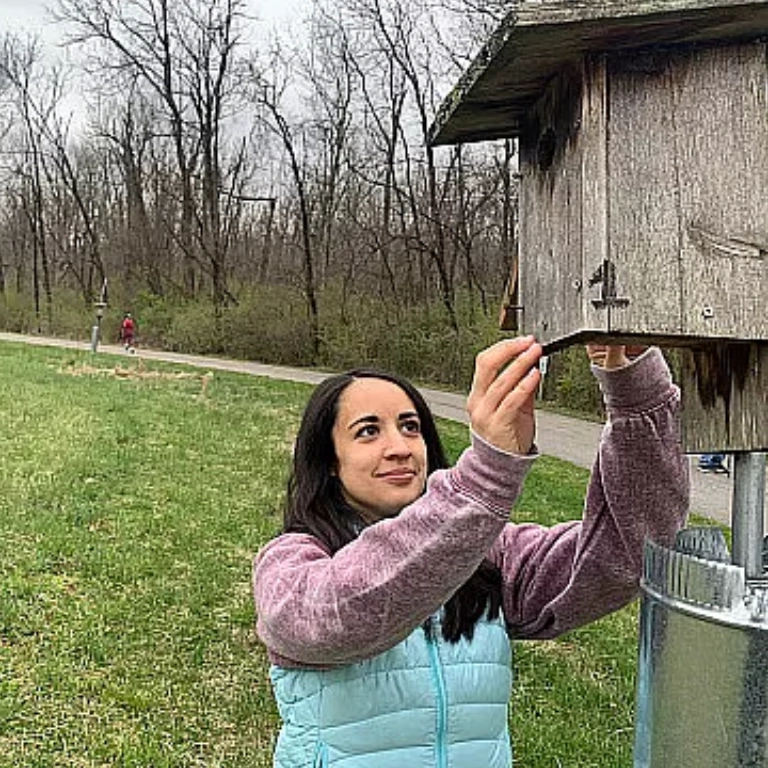This article was originally published by the IU Luddy School of Informatics, Computing, and Engineering.
Total solar eclipses only happen in the same spot once every 300 or 400 years, so it’s no surprise that a team of researchers based at Indiana University jumped on the opportunity to use this natural experiment to better understand how light affects wild birds.
Their study, led by Liz Aguilar, was published in the latest edition of Science. Aguilar is a Ph.D. student in Kimberly Rosvall’s lab in the Evolution, Ecology and Behavior program in the College of Arts and Sciences at IU Bloomington.
In a large collaboration spanning the continent, including the Luddy School of Informatics, Computing, and Engineering, researchers discovered that even when night comes at the wrong time of day and only lasts for about four minutes, many bird species sing as if it were dawn.
The paper showcases their findings from the April 8, 2024 total solar eclipse, when the moon’s shadow raced across North America, from Mazatlán to Newfoundland in just a couple of hours. In Bloomington, the eclipse lasted four minutes and 15 seconds.
The team’s unique collaboration all started when Jo Anne Tracy, College of Arts and Sciences Assistant Dean for Research and Director for Science Outreach, brought together educators to brainstorm how to enhance public engagement in science during the eclipse. This ultimately led Aguilar to partner with Paul Macklin, professor Intelligent Systems Engineering at the Luddy School of Informatics, Computing and Engineering at IU Bloomington.
Their goal was to create a free smartphone app, SolarBird, to engage the public actively in data collection, while staying true to the very best of animal behavior science. “Scientists can’t be in a thousand places at once,” Aguilar said. “The app gets around this problem by leveraging the public as scientists. It also encourages people to look around and listen, adding to the show in the sky.”
SolarBird users were asked to find a bird and observe it for 30 seconds before, during and after totality. They documented the bird’s behavior by clicking up to 10 boxes on the app, such as singing, eating or flying.
“A main theme was how we could make data collection easy for newcomers, and minimize any distractions from the day’s event,” Macklin said. “We used the smartphone’s GPS coordinates and known formulas to determine the eclipse phase, which is the percentage of sun obscured by the moon.”
Aguilar lights up when recalling the moment she saw the initial SolarBird results. “We got nearly 11,000 observations from more than 1,700 users, concentrated along the path of totality across the continent. It was important to us to publish their names in our paper.”
“It was wonderful,” Macklin said. “The app worked. And as we looked at the database that night, we saw the community had also worked its magic.”
While the app team worked feverishly to get the app deployed and approved on the Android and Apple stores, Rosvall led a separate team using automated recorders to listen to bird vocalizations in Bloomington and surrounding rural areas in the week leading up to the eclipse. These recording units – about the size of a tissue box – collected massive amounts of information.
Dustin Reichard, an alumni of the Evolution, Ecology and Behavior graduate program, helped deploy the recorders and analyze the data. Now faculty at Ohio Wesleyan University, Reichard studies animal communication, including the songs that birds use to attract mates or secure territories in the spring.
Reichard said the team used an artificial neural network called BirdNET – the same AI network used by the Merlin app that many people have on their phones – to scan many hours of recordings and identify which birds were singing before, during, and after totality. The team was able to analyze almost 100,000 bird vocalizations in record time.
Coupled with validations by the team’s expert birder, a data science specialist, and more on-the-ground support, they focused on 52 abundant species, with 29 species showing a clear change in how much they vocalized before, during, or after the total solar eclipse.
“Even a very brief disruption in light – just over four minutes in this case – can cause large changes in behavior, especially for species that naturally produce a burst of song around dawn,” Reichard said.
A year and a half later, you can still hear the wonder in Rosvall’s voice as she describes the project. “It’s crazy that you can turn off the Sun, even briefly, and birds’ physiology is so tuned to those changes that they act like it’s morning. This has important implications on the impact of urbanization or artificial light at night, which are much more widespread.”
“A lot had to align for this to work – that the eclipse would peak in this area at this time of year; that IU is a center of animal behavior research known internationally; that we had the people, the tools, and the public’s interest,” Reichard said. “Everything came together.”
The team’s combination of passive sound recording, AI-supported analysis and community science opens exciting possibilities for the future, for example studying any number of unpredictable natural events, Rosvall explained.
Rosvall said she hopes their success will encourage more scientists to engage in projects that combine AI and community science so that the public can see themselves as scientists to learn more about the world. “It was clear that engaging in this research project enhanced people’s joy in this experience,” she said. “It did for me and those who reached out.”
Rosvall, Reichard and Macklin said it was one of the most rewarding projects they have ever done. Aguilar agreed, calling it “the work she’s most proud of.”
“It shows that sometimes a creative idea and a willingness to go all in is what you need to accomplish high-impact work,” Rosvall said.
This project was supported by grants from the Indiana Space Grant Consortium and the National Science Foundation.

 The College of Arts
The College of Arts